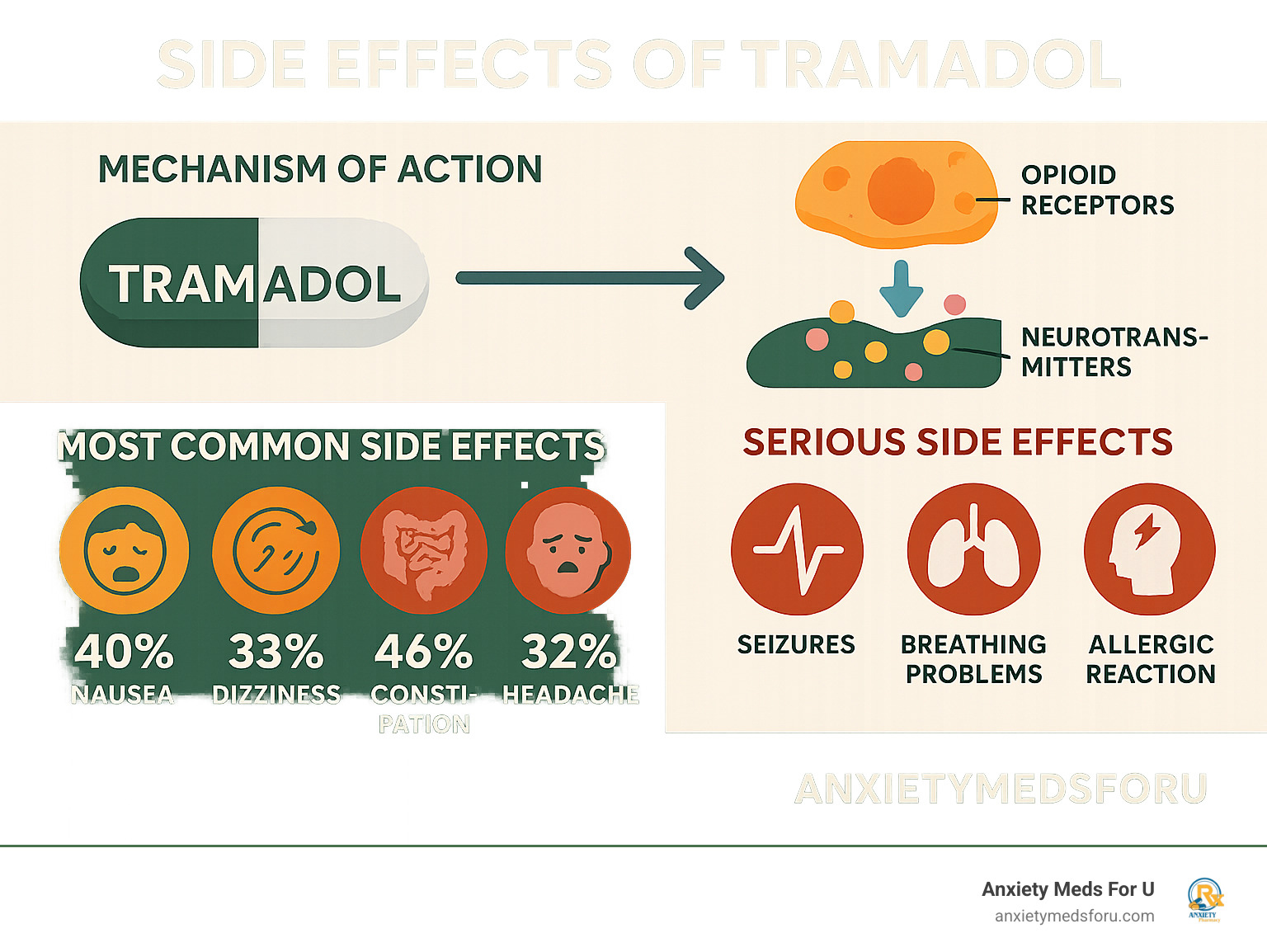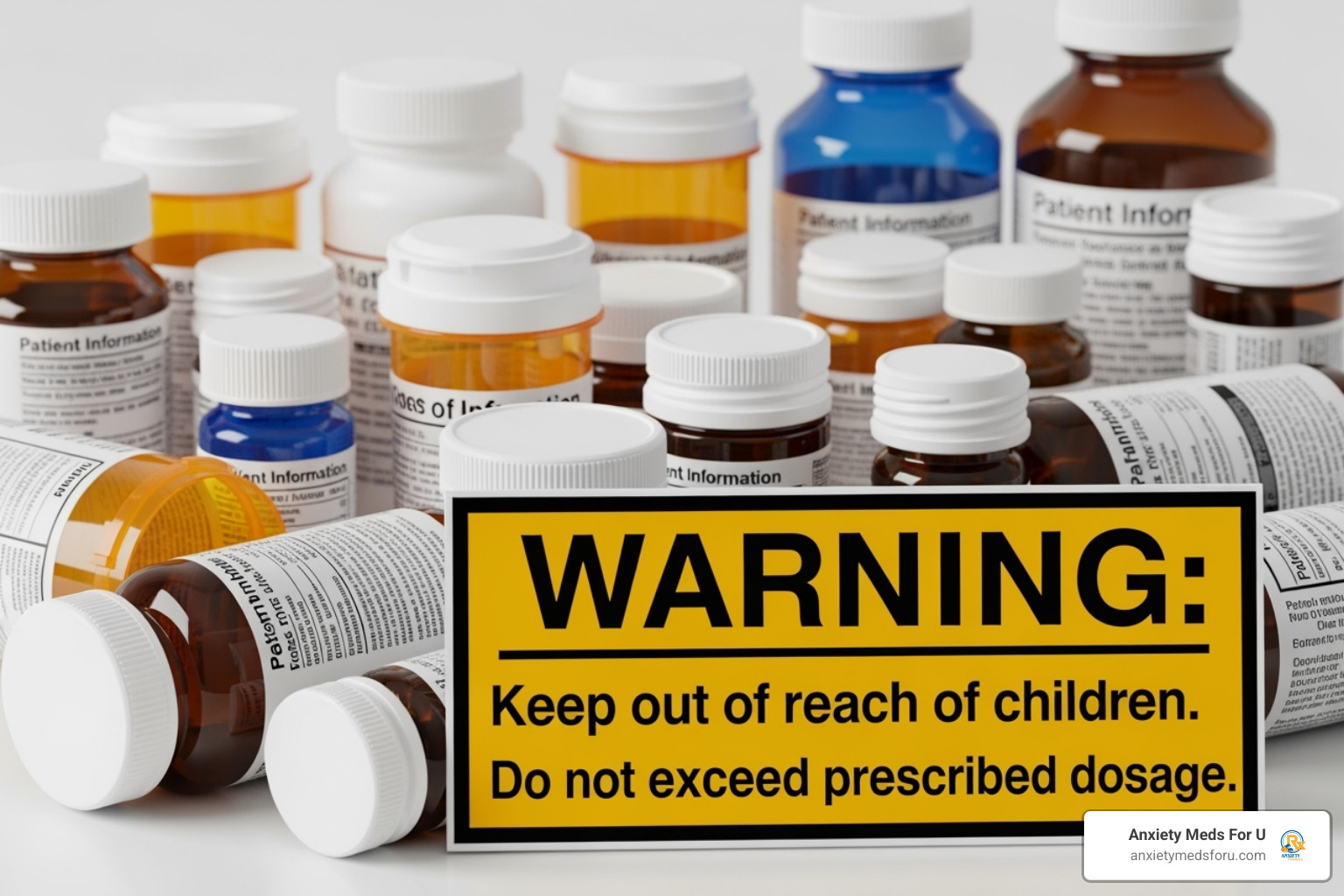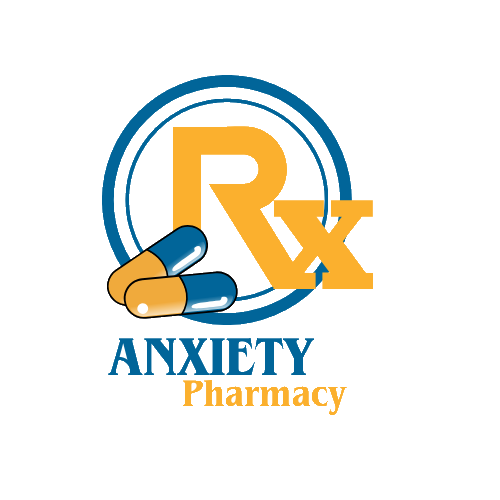Beyond Relief: Navigating Tramadol’s Potential Side Effects

Understanding Tramadol’s Side Effect Profile
The side effects of tramadol can range from mild discomfort to life-threatening complications, making it crucial to understand what you might experience when taking this powerful pain medication.
Most Common Side Effects (affecting more than 1 in 10 people):
- Nausea – affects up to 40% of users
- Dizziness – experienced by up to 33% of users
- Constipation – occurs in up to 46% of users
- Headache – reported by up to 32% of users
- Drowsiness – affects up to 25% of users
Serious Side Effects Requiring Immediate Medical Attention:
- Seizures or fits
- Breathing difficulties or shallow breathing
- Signs of allergic reaction (swollen lips, difficulty breathing)
- Extreme confusion or hallucinations
- Severe dizziness with low blood pressure
Tramadol is a synthetic opioid painkiller prescribed for moderate to severe pain when other medications haven’t provided adequate relief. While it can be highly effective for pain management, tramadol works on both opioid receptors and serotonin/norepinephrine levels in your brain – a dual action that creates its unique side effect profile.
Understanding these potential effects helps us balance the relief tramadol provides against the risks it may pose to our health and daily life. Our goal is to ensure you’re well-informed when considering tramadol for pain management. For more information on its uses, you can visit our guide on Uses of Tramadol.
I’m John, and through my extensive work helping people access affordable medications online, I’ve seen how understanding the side effects of tramadol can make the difference between safe, effective pain management and dangerous complications. My experience has shown me that informed patients make better decisions about their treatment options.

Basic side effects of tramadol terms:
Decoding the Most Common Side Effects of Tramadol
When you start taking tramadol, you’re likely to encounter some side effects of tramadol that are considered quite normal – though admittedly not very welcome guests at your pain relief party. These common effects show up in more than 1 in 10 people who take this medication, and while they’re usually not dangerous, they can definitely put a damper on your day.
The statistics tell quite a story: nausea affects up to 40% of users (making it the most frequent complaint), while constipation troubles up to 46% of people taking tramadol. Dizziness spins into about 33% of users’ lives, and headaches pound away at roughly 32% of folks. Drowsiness weighs down about 25% of users, while vomiting affects up to 17%. You might also experience sweating and dry mouth – your body’s way of adjusting to this new medication.
Why does this happen? It all comes back to how tramadol works on your central nervous system and opioid receptors. Unlike simpler pain medications, tramadol has a dual action – it affects both opioid pathways and serotonin levels in your brain. This unique mechanism is what makes it effective for pain, but it’s also why you might feel like your body is throwing a small protest. You can learn more about this process in our detailed guide on How Tramadol Works.
The silver lining? Most of these mild effects can be managed with some simple strategies, and many people find they improve as their body adjusts to the medication over the first few weeks.
Coping with Nausea and Dizziness

If you’re among the 18-25% of tramadol users dealing with dizziness or that queasy feeling of nausea, you’re definitely not alone. The good news is that these side effects of tramadol often respond well to some practical adjustments in how you take your medication and go about your day.
Taking tramadol with food is one of the most effective ways to reduce nausea. Think of food as a gentle buffer for your stomach – it helps cushion the impact of the medication and can significantly reduce that unsettled feeling. Even a small snack or glass of milk can make a difference.
Staying hydrated is crucial for managing both nausea and dizziness. Dehydration can make these symptoms much worse, so keep a water bottle nearby and take small, frequent sips throughout the day. If plain water doesn’t appeal to you when you’re feeling nauseated, try ice chips or clear fluids like ginger ale.
When dizziness strikes, avoiding sudden movements becomes your new best friend. Stand up slowly from sitting or lying positions, and give your body a moment to adjust before walking. If you’re experiencing true vertigo – where you feel like you or the room is spinning – this is slightly different from regular dizziness and may need specific attention from your doctor.
The difference between regular dizziness and vertigo matters: dizziness usually feels like lightheadedness or unsteadiness, while vertigo creates a spinning sensation that can be quite disorienting and may indicate other underlying issues that need medical evaluation.
Managing Constipation and Other Discomforts
Constipation is perhaps the most persistent companion of opioid medications like tramadol, affecting up to 46% of users. This happens because tramadol slows down your digestive system – while it’s busy blocking pain signals, it’s also putting the brakes on normal bowel function. But don’t worry, this is a battle you can win with the right approach.
Dietary fiber becomes your digestive system’s best ally. Think of fiber as nature’s gentle broom, helping to keep things moving smoothly through your system. Increased fluid intake works hand-in-hand with fiber – water helps soften everything and makes elimination much easier and more comfortable.
If dietary changes aren’t quite doing the trick, laxatives recommended by your healthcare provider can offer additional relief. Don’t be shy about discussing this with your doctor or pharmacist – they’ve heard it all before and can suggest the most appropriate options for your situation.
Beyond constipation, you might notice itching or muscle weakness as other common discomforts. The itching is usually mild and may come and go, while muscle weakness tends to be more noticeable when you first start the medication or increase your dose.
- Whole grains like oats, brown rice, and whole-wheat bread
- Fresh fruits such as berries, apples with skin, pears, and prunes
- Vegetables including broccoli, Brussels sprouts, carrots, and leafy greens
- Legumes like beans, lentils, and chickpeas
- Nuts and seeds such as almonds, chia seeds, and flaxseeds
These common side effects of tramadol are usually manageable and often improve as your body adjusts to the medication. If any of these effects persist, worsen, or significantly impact your daily life, don’t hesitate to reach out to your healthcare provider for guidance and possible adjustments to your treatment plan.
Serious Side Effects: When to Seek Immediate Medical Help

While most people taking tramadol experience only mild discomfort, there’s a darker side we need to talk about. Some side effects of tramadol cross the line from bothersome to downright dangerous, and recognizing them could literally save your life or someone else’s.
These serious complications are thankfully rare, affecting fewer than 1 in 100 people, but when they happen, every second counts. We’re not trying to scare you here – we just want you prepared and informed.
The red-flag symptoms that demand immediate emergency care include seizures or fits (any kind of uncontrolled shaking or loss of consciousness), respiratory depression (when your breathing becomes dangerously slow or shallow), and severe low blood pressure that makes you feel faint or dizzy when standing up.
You should also watch for hallucinations (seeing or hearing things that aren’t there), sudden confusion that’s different from normal drowsiness, urinary retention (being unable to urinate despite feeling the need), and anaphylaxis – a severe allergic reaction that can shut down your entire system.
If any of these happen to you or someone you’re with, don’t second-guess yourself. Call emergency services immediately. It’s always better to have a false alarm than to miss a real emergency.
Signs of a Serious Allergic Reaction
Your body’s immune system is usually your friend, but sometimes it can overreact to tramadol in a way that becomes life-threatening. This severe allergic reaction, called anaphylaxis, can develop within minutes and requires immediate emergency treatment.
The warning signs are unmistakable once you know what to look for. Swollen lips, tongue, or throat can block your airway, while difficulty breathing, wheezing, or choking means your respiratory system is in distress. You might feel a tightness in your throat or sense that there’s a lump blocking your breathing.
Your skin can tell the story too – look for skin rashes that appear as hives, blistering, or raised, itchy patches. Your circulation might be affected, causing fainting or loss of consciousness, and in severe cases, your skin might turn blue, grey, or pale, especially around your lips and fingertips.
If you witness these symptoms in yourself or others, don’t try to drive to the hospital. Call for emergency medical help right away – paramedics have the tools and training to handle anaphylaxis on the spot.
Understanding Seizures and Serotonin Syndrome
Two of the most serious side effects of tramadol deserve special attention because they’re both rare and potentially deadly: seizures and serotonin syndrome.
Tramadol has an increased seizure risk that sets it apart from other pain medications. Even when taken exactly as prescribed, it can trigger seizures in people who’ve never had them before. This risk jumps significantly if you already have a seizure disorder or take other medications that affect your brain’s electrical activity.
Then there’s serotonin syndrome – a condition that sounds complicated but is essentially your brain being flooded with too much of the “feel-good” chemical serotonin. Since tramadol naturally increases serotonin levels, combining it with certain antidepressants, migraine medications, or even some herbal supplements can create a perfect storm.
The symptoms of serotonin syndrome often start with agitation and muscle spasms, then progress to fever and excessive sweating. You might experience rapid heart rate, high blood pressure, and loss of coordination. In severe cases, confusion and hallucinations can develop, along with nausea, vomiting, or diarrhea.
Both seizures and serotonin syndrome are medical emergencies that require immediate professional treatment. For more detailed medical information about this dangerous condition, you can read about What is serotonin syndrome and how does it relate to tramadol use?.
This is exactly why your doctor needs to know about every single medication, supplement, and herbal remedy you’re taking – even the ones you think are harmless. What seems like a simple pain reliever can become dangerous when mixed with the wrong combination of other substances.
The Long-Term Picture: Dependence, Tolerance, and Other Dangers
Let’s talk about what happens when tramadol becomes a long-term companion in your pain management journey. It’s a conversation that requires honesty, because understanding these risks helps you make informed decisions about your health.
When we discuss long-term tramadol use, we need to understand the difference between physical dependence and addiction – two terms that often get mixed up but mean very different things. Physical dependence is your body’s natural response to regular medication use. Think of it like your body getting used to having tramadol around and needing time to readjust if you stop taking it suddenly. This can happen even when you’re taking your medication exactly as your doctor prescribed.
Addiction, however, is a different beast entirely. It involves compulsive drug-seeking behavior and continuing to use the medication despite harmful consequences. Your brain chemistry actually changes, particularly in the reward centers, creating powerful cravings and altered decision-making patterns.
Tolerance development is another reality of long-term tramadol use. Your body becomes accustomed to the medication, meaning you might need higher doses over time to get the same pain relief. It’s like your body’s pain receptors become less sensitive to the drug’s effects. This gradual increase can inadvertently bump up your risk of experiencing more side effects of tramadol.
There’s also something called hyperalgesia – a rather ironic condition where long-term opioid use actually increases your sensitivity to pain. Your body essentially becomes more aware of painful sensations, which is the opposite of what we’re trying to achieve with pain medication.
Understanding these aspects of Tramadol helps you work with your healthcare provider to manage your pain effectively while minimizing long-term risks. The key is finding that sweet spot between adequate pain relief and safety.
The Risks of Addiction and Dependence

Here’s a sobering statistic: one-third of long-term tramadol users can develop dependence. While tramadol is often considered a “gentler” opioid, it still packs a punch when it comes to addiction potential. Some research suggests that around 1 in 4 patients end up misusing tramadol, which really drives home why careful monitoring is so important.
When addiction takes hold, it’s because tramadol has literally rewired parts of your brain, especially the reward centers that control motivation and pleasure. The changes aren’t just psychological – they’re physical alterations to brain structure and chemistry.
You might notice cravings that feel almost impossible to ignore, like a persistent voice in your head demanding more medication. Some people start doctor shopping, visiting multiple healthcare providers to get additional prescriptions without telling each doctor about the others. It’s a dangerous game that often leads to taking much higher doses than any single doctor would recommend.
Neglecting responsibilities becomes common as the medication takes priority over work commitments, family time, or social obligations. People might start hiding their use from loved ones, becoming secretive about when and how much they’re taking. Relationships often suffer as the focus shifts from meaningful connections to maintaining access to the drug.
The tricky part is that physical dependence can develop even when you’re following your prescription perfectly. But when dependence crosses into addiction territory, professional help becomes essential. If you recognize these patterns in yourself or someone you care about, reaching out to a healthcare provider or addiction specialist can be life-changing.
Potential for Long-Term Organ Damage
While tramadol is generally safe for short-term use, long-term exposure can create concerns for various organs and body systems. Let’s walk through what we know about these potential risks.
Your liver bears the brunt of processing tramadol, breaking it down so your body can use and eliminate it. Under normal circumstances and typical doses, your liver handles this just fine. But higher doses, extended use, interactions with other medications, and even genetic factors can increase the risk of liver damage. This is especially true if you’re taking other medications that also rely heavily on liver processing. For detailed information about these risks, you can check out Information on tramadol and liver health from LiverTox.
Your kidneys have a different relationship with tramadol. The medication doesn’t typically damage healthy kidneys directly, but if your kidney function is already compromised, tramadol can build up in your system. This leads to higher concentrations in your blood and potentially more pronounced side effects of tramadol. That’s why doctors often adjust dosages for people with kidney problems.
Brain changes from long-term opioid use can be subtle but significant. We’re talking about alterations in cognition and memory that might creep up slowly. Part of this comes from the medication’s effects on breathing – even slight respiratory depression over time can mean less oxygen reaching your brain. These changes might show up as difficulty concentrating, problems with short-term memory, or challenges learning new information.
Your endocrine system – the network of glands that produce hormones – can also feel the impact. Long-term tramadol use might affect your thyroid function, leading to changes in metabolism, energy levels, and even mood. It can also impact sex hormones, potentially reducing libido and affecting fertility in both men and women.
These long-term risks highlight why tramadol should always be used under careful medical supervision and for the shortest duration that provides adequate pain relief. It’s about finding the balance between managing your pain and protecting your overall health.
Critical Risks: Overdose, Interactions, and Special Populations

When it comes to the side effects of tramadol, some situations can turn truly dangerous. Think of it like driving a car – most of the time you’re fine, but certain conditions make everything much riskier. Overdose, dangerous drug combinations, and specific vulnerable groups create scenarios where tramadol’s risks skyrocket beyond typical side effects.
Tramadol overdose is a medical emergency that happens more often than you might think. Over 44,000 Americans ended up in emergency rooms due to tramadol misuse in just one year. The signs are unmistakable and terrifying: dangerously slow or stopped breathing, extreme drowsiness where you can’t wake someone up, pinpoint pupils that look like tiny dots, slowed heartbeat, cold and clammy skin, muscle weakness, and complete unresponsiveness.
If you see these symptoms, don’t hesitate – call emergency services immediately. Having naloxone (Narcan) on hand can literally save a life while waiting for help to arrive.
Dangerous Drug and Alcohol Interactions
Here’s where things get really serious. Mixing tramadol with certain substances is like playing Russian roulette with your brain chemistry. The most dangerous combination? Alcohol. Both tramadol and alcohol slow down your central nervous system, and together they can slow your breathing to a deadly crawl.
Other CNS depressants create similar risks. We’re talking about benzodiazepines like Xanax or Valium, other opioid medications, sleep aids, and muscle relaxants. Each one amplifies tramadol’s sedating effects, pushing you toward respiratory depression and potential overdose.
The serotonin story gets complicated too. Certain antidepressants like SSRIs and SNRIs can trigger serotonin syndrome when combined with tramadol. This also includes migraine medications called triptans and even that innocent-looking St. John’s wort supplement sitting in your medicine cabinet. For detailed information about these risky combinations, check out More on opioid and antidepressant combinations.
Carbamazepine presents a double problem – it can make tramadol less effective while increasing seizure risk. And MAO inhibitors? Never, ever take tramadol with these older antidepressants or within 14 days of stopping them. The risk of severe reactions is just too high.
Some medications mess with how your body processes tramadol, either speeding it up or slowing it down. This can leave you with either ineffective pain relief or dangerously high tramadol levels coursing through your system.
Special Warnings for Children, Pregnancy, and the Elderly
Some people face extra risks with the side effects of tramadol, and the FDA has issued specific warnings for good reason.
Children under 12 should never receive tramadol, period. For teenagers between 12 and 18, the risks are still significant, especially after tonsil or adenoid surgery where severe breathing problems and deaths have occurred. Some kids are “ultra-rapid metabolizers” – their bodies process tramadol so quickly that even a standard dose like Tramadol 50mg can create dangerously high levels in their bloodstream.
Pregnant women face a heartbreaking dilemma. Long-term tramadol use can cause Neonatal Opioid Withdrawal Syndrome (NOWS) in newborns. Picture tiny babies experiencing withdrawal – irritability, high-pitched crying, tremors, feeding problems, and even seizures. It’s as difficult as it sounds, requiring immediate medical care.
Elderly patients over 65 deal with their own unique challenges. Their bodies process medications differently, making them more vulnerable to dizziness, drowsiness, and confusion. This dramatically increases fall risk – and we all know how dangerous falls can be for older adults. They’re also more likely to develop low blood sodium levels within the first week of starting tramadol, which can cause serious complications.
These aren’t just precautions written in fine print. They’re real risks that require careful medical supervision and honest conversations with healthcare providers about age, health status, and other medications.
Managing Your Treatment and Exploring Safer Use
When you’re dealing with pain and considering tramadol, think of your healthcare provider as your co-pilot on this journey. The most successful pain management happens when you’re both working together, sharing information openly and honestly. Don’t hold back when discussing your pain levels, how the medication is affecting you, or any concerns about the side effects of tramadol you might be experiencing.
Here’s something that might surprise you: taking more tramadol than prescribed won’t necessarily give you better pain relief, but it will definitely increase your risk of dangerous side effects. It’s like turning up the volume on a broken speaker – you just get more distortion, not clearer sound. If your current dose, whether it’s Tramadol 100mg or another strength, isn’t managing your pain effectively, resist the urge to self-adjust. Instead, have that conversation with your doctor.
Your healthcare provider has tools and strategies you might not know about. They can assess whether a dosage adjustment is safe, explore combination therapies, or suggest alternative approaches that might work better for your specific situation.
How to Safely Stop or Dispose of Tramadol
Picture this: you’ve been taking tramadol regularly, and now you and your doctor have decided it’s time to stop. Your first instinct might be to just quit cold turkey – after all, isn’t that the fastest way? Unfortunately, that’s also the most uncomfortable and potentially dangerous way.
Suddenly stopping tramadol can trigger withdrawal symptoms that feel pretty miserable. We’re talking about nervousness that makes you feel like you’ve had ten cups of coffee, panic attacks, sweating, chills, nausea that makes you not want to look at food, and in severe cases, even hallucinations. Nobody wants to deal with that.
That’s why your doctor will likely suggest tapering off medication – gradually reducing your dose over days or weeks. Think of it like slowly turning down the volume instead of hitting the mute button. This withdrawal management approach gives your body time to adjust and significantly reduces those uncomfortable symptoms.
Now, what about those leftover pills? Please don’t flush them down the toilet or toss them in the trash. Flushing medications can harm our water systems and the wildlife that depends on them. Throwing loose pills in the garbage puts children, pets, and even sanitation workers at risk.
The gold standard for getting rid of unused tramadol is through Safe disposal via take-back programs. Many pharmacies and community centers host these events, and some police stations have permanent drop-off boxes. It’s a small step that makes a big difference for everyone’s safety.
Approaches to Pain Management with Tramadol
Effective pain management isn’t just about finding the right pill – it’s about creating a comprehensive strategy that works for your life. Tramadol can be an excellent tool in your pain management toolkit, but like any tool, it works best when used correctly and as part of a bigger plan.
Adjusting dosage with medical guidance means working closely with your doctor to find that sweet spot – the lowest dose that gives you meaningful pain relief. If you’re taking a higher strength like Tramadol 200mg, this becomes even more critical. Higher doses can be effective for severe pain, but they also come with increased risks that require careful medical supervision.
Monitoring for side effects doesn’t have to be complicated. Consider keeping a simple pain and symptom diary – note your pain levels, any side effects you experience, and how the medication affects your daily activities. This information becomes invaluable during your medical appointments and helps your doctor make informed decisions about your treatment.
Many people find success combining tramadol with non-opioid pain relievers. Your doctor might suggest pairing it with acetaminophen or ibuprofen (if they’re safe for you), which can often provide better pain control while allowing you to use a lower tramadol dose. It’s like having a team of medications working together instead of relying on just one player.
Don’t underestimate the power of lifestyle adjustments to support pain relief. Physical therapy can teach you exercises and techniques that address the root causes of your pain. Regular, gentle exercise – even just walking – can release natural pain-fighting chemicals in your body. Mindfulness practices and stress reduction techniques can help you manage the emotional aspects of chronic pain, which often makes the physical pain feel more manageable too.
The ultimate goal isn’t just to eliminate pain – it’s to help you live a fuller, more comfortable life while keeping the risks as low as possible. Sometimes that means accepting that some pain might remain while focusing on improving your overall quality of life and function.
Frequently Asked Questions about Tramadol’s Effects
You know, after years of helping people steer their pain management journey, I’ve noticed the same questions come up again and again. These aren’t just casual curiosities – they’re the real concerns that keep people up at night when they’re considering or already taking tramadol. Let me share what I’ve learned from countless conversations with patients and healthcare providers.
How long do the side effects of tramadol usually last?
This is probably the most common question I hear, and honestly, it’s one of the most important ones to ask. The side effects of tramadol don’t all follow the same timeline, which can be both reassuring and frustrating.
For most people, the common side effects like nausea, dizziness, and that groggy feeling start to ease up within the first few days to a week. Your body is pretty amazing at adapting, and what feels overwhelming on day one often becomes much more manageable by day seven. It’s like your system is learning to work with the medication rather than against it.
But here’s where it gets tricky – not all side effects follow this pattern. Constipation, for example, can be a persistent companion for as long as you’re taking tramadol. And drowsiness after each dose might continue throughout your treatment, especially if you’re on a higher dose.
The most critical window is actually the first 24 to 72 hours, particularly for serious effects like breathing problems. This is when your doctor will want to hear from you if anything feels off. If you’re experiencing side effects that are severe, getting worse instead of better, or just won’t go away after that initial adjustment period, don’t tough it out – contact your doctor.
Can tramadol cause mood swings or anxiety?
This question always makes me pause because it touches on something that catches many people off guard. Yes, tramadol absolutely can affect your mood and mental state, and it’s not just about the physical side effects.
Remember how tramadol works differently from other pain medications? It doesn’t just target opioid receptors – it also messes with serotonin and norepinephrine levels in your brain. These are the same chemicals that antidepressants target, so it makes sense that changes here can affect how you feel emotionally.
Some people experience mood swings that feel like they’re on an emotional roller coaster. Others might notice increased anxiety, feeling agitated for no clear reason, or experiencing confusion that wasn’t there before. In rare cases, people report more serious psychological effects like paranoia or even hallucinations.
The link to serotonin levels is particularly important here. If your serotonin gets too high (especially if you’re taking other medications that affect serotonin), it can create a cascade of mood-related symptoms. This isn’t something to brush off – significant changes in your mood or sudden onset of anxiety deserve a conversation with your doctor.
Is it safe to drive after taking tramadol?
I’m going to be straight with you on this one: it’s generally not safe to drive after taking tramadol, especially when you’re first starting the medication or adjusting your dose.
Here’s the reality – tramadol can cause significant drowsiness, dizziness, and impaired coordination. We’re talking about up to 1 in 8 users experiencing coordination problems. When you’re behind the wheel, you need every bit of your mental alertness and physical coordination. There’s no room for compromise when it comes to safety.
The tricky part is that you might feel fine, but your reaction times could still be slower than normal. It’s like having a couple of drinks – you might think you’re okay to drive, but your judgment and reflexes are actually impaired.
My advice? Don’t drive until you know exactly how tramadol affects you personally. Give it at least a few days to see how your body responds. If you’re feeling drowsy, dizzy, or just “off” in any way, ask someone else to drive or use alternative transportation. This guidance applies whether you’re getting your medication through traditional channels or following The 10 Commandments of Buying Tramadol Online.
Trust me, no appointment or errand is worth risking your safety or someone else’s. When in doubt, don’t drive.
Conclusion
After walking through this comprehensive journey together, we’ve uncovered the full spectrum of side effects of tramadol – from those everyday annoyances like nausea and dizziness that affect nearly half of users, to the serious complications like seizures and respiratory depression that demand immediate medical attention. We’ve also explored how long-term use can lead to dependence, tolerance, and potential organ damage, while highlighting the critical importance of avoiding dangerous interactions with alcohol and other medications.
The reality is that tramadol sits in a unique position in pain management. It’s more complex than many people realize, working on both opioid receptors and brain chemicals like serotonin. This dual action makes it effective for many types of pain, but it also creates a distinctive risk profile that requires careful consideration.
Balancing pain relief with safety isn’t always straightforward. What we’ve learned is that informed use – understanding what to expect, knowing when to seek help, and maintaining open communication with healthcare providers – makes all the difference. Whether you’re dealing with chronic pain that affects your daily life or recovering from an injury, having this knowledge empowers you to make better decisions about your treatment.
At Anxiety Meds For U, we understand that accessing effective pain management can be challenging and expensive. For those who understand the risks and need effective pain management, you can explore your options discreetly and affordably through our platform. We’re committed to providing accessible solutions while always emphasizing the importance of responsible use and staying informed about potential risks.
Every person’s experience with tramadol is different. What matters most is that you’re equipped with the knowledge to recognize both the benefits and the warning signs, so you can work with your healthcare provider to find the safest, most effective approach to managing your pain. You can explore and Buy Tramadol Online through our secure platform when you’re ready to take that next step in your pain management journey.












